Unit 8 Is there a post office near here?单元知识点课件(共24张PPT)
文档属性
| 名称 | Unit 8 Is there a post office near here?单元知识点课件(共24张PPT) | 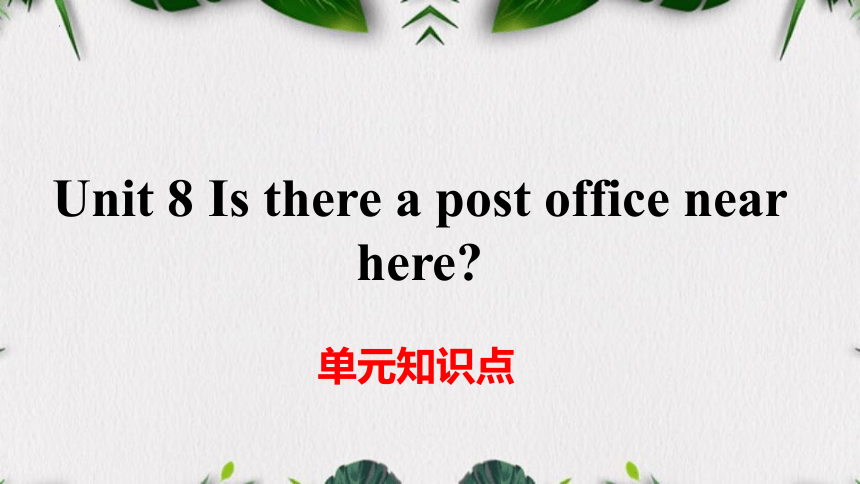 | |
| 格式 | pptx | ||
| 文件大小 | 428.3KB | ||
| 资源类型 | 教案 | ||
| 版本资源 | 人教新目标(Go for it)版 | ||
| 科目 | 英语 | ||
| 更新时间 | 2023-06-20 16:08:15 | ||
图片预览

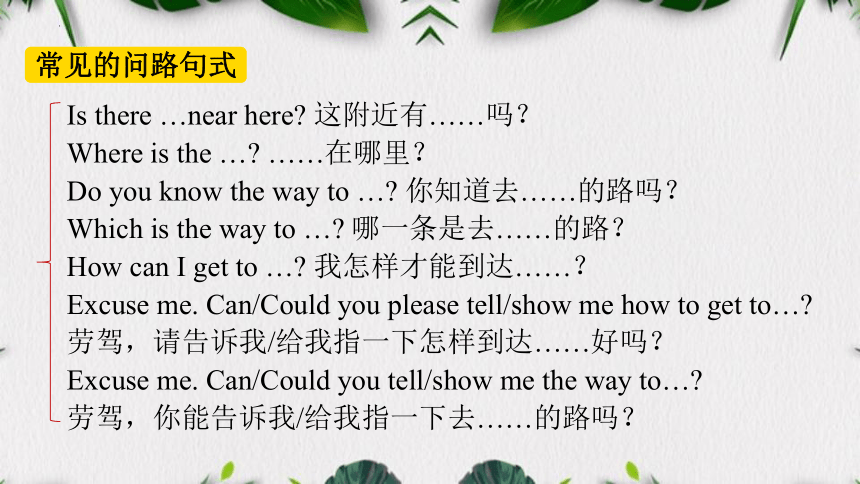

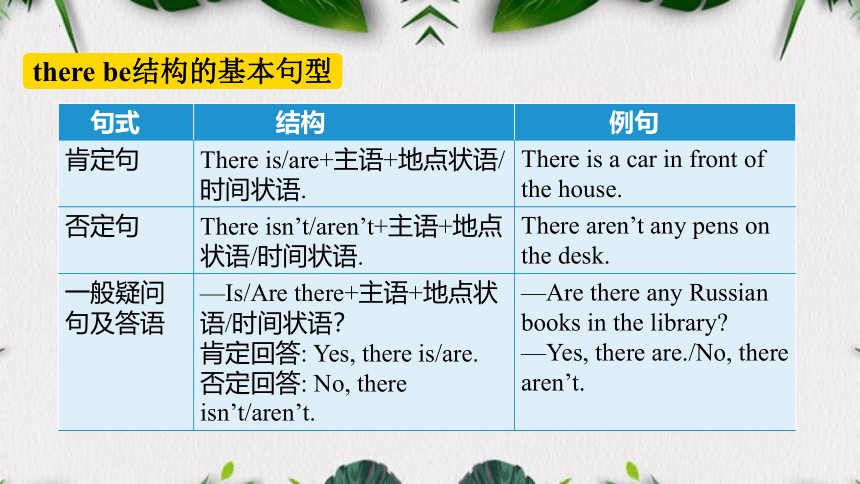
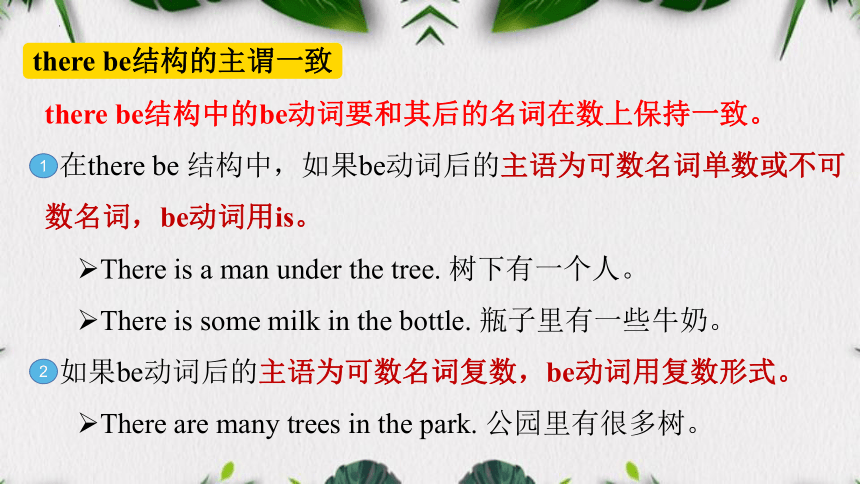
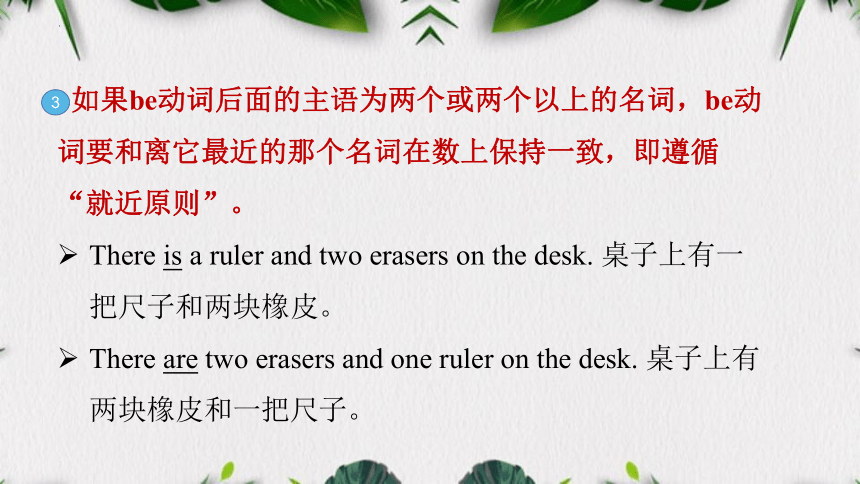
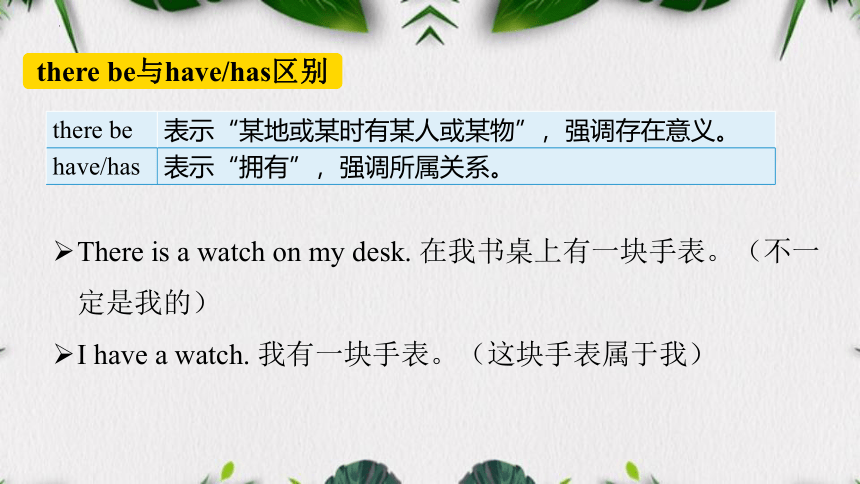

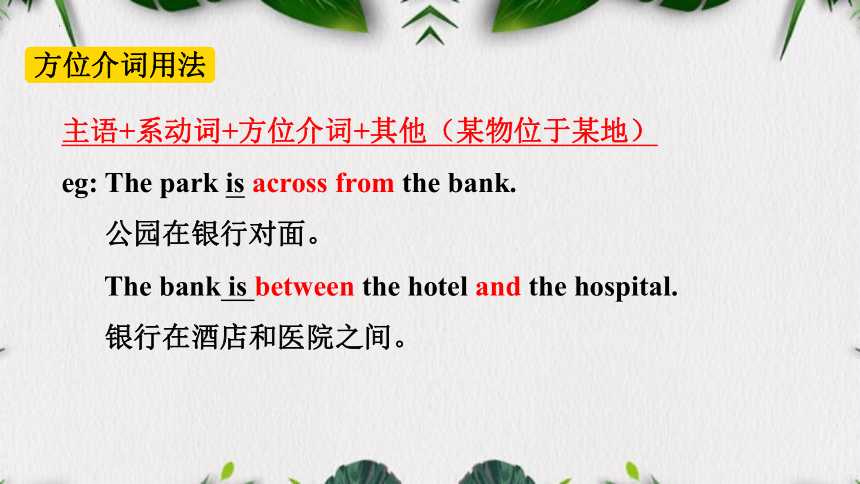
文档简介
(共24张PPT)
单元知识点
Unit 8 Is there a post office near here
常见的问路句式
Is there …near here 这附近有……吗?
Where is the … ……在哪里?
Do you know the way to … 你知道去……的路吗?
Which is the way to … 哪一条是去……的路?
How can I get to … 我怎样才能到达……?
Excuse me. Can/Could you please tell/show me how to get to…
劳驾,请告诉我/给我指一下怎样到达……好吗?
Excuse me. Can/Could you tell/show me the way to…
劳驾,你能告诉我/给我指一下去……的路吗?
常见的指路句式
It’s on …Street/Road. 它在……街/路。
It’s in front of/near/across from/ behind the…
它在……前面/附近/对面/后面。
Walk/Go along/down…Street/Road. 沿着……街/路走。
Turn right/left at the …crossing. 在第……个十字路口向右/左转。
Take the…turning on the right/left. 在第……个转弯处向右/左转。
Take the No. …bus and get off at…
乘坐……路公共汽车,在……下车。
there be结构的基本句型
句式 结构 例句
肯定句 There is/are+主语+地点状语/时间状语. There is a car in front of the house.
否定句 There isn’t/aren’t+主语+地点状语/时间状语. There aren’t any pens on the desk.
一般疑问句及答语 —Is/Are there+主语+地点状语/时间状语? 肯定回答: Yes, there is/are. 否定回答: No, there isn’t/aren’t. —Are there any Russian books in the library
—Yes, there are./No, there aren’t.
there be结构的主谓一致
there be结构中的be动词要和其后的名词在数上保持一致。
在there be 结构中,如果be动词后的主语为可数名词单数或不可数名词,be动词用is。
There is a man under the tree. 树下有一个人。
There is some milk in the bottle. 瓶子里有一些牛奶。
如果be动词后的主语为可数名词复数,be动词用复数形式。
There are many trees in the park. 公园里有很多树。
1
2
如果be动词后面的主语为两个或两个以上的名词,be动词要和离它最近的那个名词在数上保持一致,即遵循“就近原则”。
There is a ruler and two erasers on the desk. 桌子上有一把尺子和两块橡皮。
There are two erasers and one ruler on the desk. 桌子上有两块橡皮和一把尺子。
3
there be与have/has区别
there be 表示“某地或某时有某人或某物”,强调存在意义。
have/has 表示“拥有”,强调所属关系。
There is a watch on my desk. 在我书桌上有一块手表。(不一定是我的)
I have a watch. 我有一块手表。(这块手表属于我)
方位介词总结
near
across from
next to
between…and
in front of
behind
on
在…附近
在…对面
贴近,紧挨着
在…和…之间(2者)
在…前面(外部)
在…之后
在…上
主语+系动词+方位介词+其他(某物位于某地)
eg: The park is across from the bank.
公园在银行对面。
The bank is between the hotel and the hospital.
银行在酒店和医院之间。
方位介词用法
Language points
1. police station 警察局
police n. 警察
police是集合名词,表示复数意义,其前通常加定冠词the,作主语时谓语动词通常用复数形式。
The police are looking for the lost child. 警察正在寻找那个走失的孩子。
【拓展延伸】
police
policeman(pl. policemen)
(男)警察
policewoman(pl. policewomen)
女警察
2. Is there a hospital near here 这附近有医院吗?
“Is/Are there… ”意为“有……吗?”,是 “There is/are…”的一般疑问句形式。 Be动词要与后面的主语保持一致,其肯定回答是 “Yes, there is/are.”, 否定回答是“No, there isn’t/aren’t”。
Is/Are there…
—Is there a museum near here 这附近有博物馆吗?
—Yes, there is. 是的,有。
—Are there any people in the meeting room 会议室里有人吗?
—No, there aren’t. 不,没有。
3. pay phone 付费电话
pay n./v. 支付;付费
pay作名词,还可意为“薪水” , a pay rise 加薪
pay作动词,常用短语:
pay...for... 为……付费;为……付出代价
across adv. & prep. 过;穿过
across既可作副词又可作介词,across from意为“在……对面”。across作介词时,常与walk, go, run等动词搭配使用。
Our school is just across from the bank. 我们学校在银行正对面。
Alice stood up and ran across the field after the rabbit. 艾丽斯站起来,跑着穿过田地去追兔子。
4. The pay phone is across from the library. 付费电话在图书馆对面。
【易混辨析】across, over, past与through
across 指从物体表面横向穿过,由一边到另一边。 You mustn’t go across the street when the traffic lights are red.
over 多指从物体上方翻越或跨越。 He climbed over the mountains to get there.
past 指从物体旁边经过。 I go past your house on my way home every day.
through 强调从物体内部或中间穿过。 The bird flew in through the window.
5. The pay phone is in front of the library. 付费电话在图书馆前面。
in front of 在……前面
【易混辨析】in front of 与 in the front of
in front of 在物体外部的前面 There is a cat in front of the car. 这辆汽车的前面有一只猫。
in the front of 在物体内部的前面 The driver is in the front of the car.司机在汽车的前面。
7. There is a zoo in my neighborhood.
neighborhood n. 街区;街坊
【常用短语】
in the neighborhood 在附近
in the neighborhood of ... 在……附近
【拓展延伸】
neighbor n. 邻居 (可数名词)
e.g. Simon and Alice are both my neighbors.
8.I like to spend time there on weekends. 我喜欢在那儿度过周末时光。
spend v. 花(时间、钱等);度过
Friends are an important part of our lives. We spend time with them, have fun together, and share our opinions, feelings and even secrets. 朋友是我们人生中重要的一部分。我们与之共度时光,共享欢乐,分享观点、心情甚至秘密。
【易混辨析】spend, cost, pay 与 take
常用结构构
spend
cost
pay
take
事/物 +cost(s)+
+
+ pays+
+for + 物
It takes+
+时间 + to do sth.
9. I love to watch the monkeys climbing around.我喜欢看猴子们爬来爬去。
watch sb./sth. doing sth. 看某人/某物在做某事
【易混辨析】watch sb./sth. doing sth. 与watch sb./sth. do sth.
watch sb./sth. doing sth. 意为“看某人/某物在做某事”,强调看到动作正在进行。 I watched Gina playing the piano.我看吉娜在弹钢琴。
watch sb./sth. do sth. 意为“观看某人/某物做某事”,强调看到动作经常发生或看到动作发生的全过程。 I often watch Gina play the piano.
我经常看吉娜弹钢琴。
10. It is very quiet and I enjoy reading there. 那儿很安静,我喜欢在那里看书
enjoy v. 享受;喜爱
enjoy作动词,常见用法有:
enjoy sth. 享受某物(的乐趣)
I really enjoyed the weekend. 我很享受这个周末。
(2) enjoy doing sth. 喜欢做某事
Sunny’s uncle is a teacher. He enjoys staying with kids. 桑妮的叔叔是一名老师,他喜欢和孩子们待在一起。
(3) enjoy oneself 过得高兴,玩得愉快
Family members always get together to enjoy themselves on the Mid-autumn Day. 家人们总是在中秋节团聚在一起玩得很开心。
Exercises
一、用be动词的适当形式填空。
1.—______ there any pictures on the wall
—Yes, there _______.
2.There _____ some water in the glass.
3.There ______ a book and two rulers on the desk.
4.There _____ some books and a pen on the chair.
Are
is
is
are
are
二、单项选择。
1.There _______ a large bowl of jiaozi on the table.
A. is B. are C. be D.has
2.—Lucy, there _____ too many things on the desk. What a mess!
—Sorry, Mum. I’ll put them away.
A. have B. is C. are D.be
3.—Is there a bank near here
—Yes, _________.
A. there is B. there isn’t C. it is D.there be
C
A
A
C
1.There is a pay phone near the school.(改为一般疑问句)
________ ______ a pay phone near the school
2.The bank is across from the hotel. (对画线部分提问)
_______ ______ the bank
3.Is there a bird in the tree (作否定回答)
No, _____ ________.
三、按要求完成句子,每空一词。
Is there
Where is
there isn’t
单元知识点
Unit 8 Is there a post office near here
常见的问路句式
Is there …near here 这附近有……吗?
Where is the … ……在哪里?
Do you know the way to … 你知道去……的路吗?
Which is the way to … 哪一条是去……的路?
How can I get to … 我怎样才能到达……?
Excuse me. Can/Could you please tell/show me how to get to…
劳驾,请告诉我/给我指一下怎样到达……好吗?
Excuse me. Can/Could you tell/show me the way to…
劳驾,你能告诉我/给我指一下去……的路吗?
常见的指路句式
It’s on …Street/Road. 它在……街/路。
It’s in front of/near/across from/ behind the…
它在……前面/附近/对面/后面。
Walk/Go along/down…Street/Road. 沿着……街/路走。
Turn right/left at the …crossing. 在第……个十字路口向右/左转。
Take the…turning on the right/left. 在第……个转弯处向右/左转。
Take the No. …bus and get off at…
乘坐……路公共汽车,在……下车。
there be结构的基本句型
句式 结构 例句
肯定句 There is/are+主语+地点状语/时间状语. There is a car in front of the house.
否定句 There isn’t/aren’t+主语+地点状语/时间状语. There aren’t any pens on the desk.
一般疑问句及答语 —Is/Are there+主语+地点状语/时间状语? 肯定回答: Yes, there is/are. 否定回答: No, there isn’t/aren’t. —Are there any Russian books in the library
—Yes, there are./No, there aren’t.
there be结构的主谓一致
there be结构中的be动词要和其后的名词在数上保持一致。
在there be 结构中,如果be动词后的主语为可数名词单数或不可数名词,be动词用is。
There is a man under the tree. 树下有一个人。
There is some milk in the bottle. 瓶子里有一些牛奶。
如果be动词后的主语为可数名词复数,be动词用复数形式。
There are many trees in the park. 公园里有很多树。
1
2
如果be动词后面的主语为两个或两个以上的名词,be动词要和离它最近的那个名词在数上保持一致,即遵循“就近原则”。
There is a ruler and two erasers on the desk. 桌子上有一把尺子和两块橡皮。
There are two erasers and one ruler on the desk. 桌子上有两块橡皮和一把尺子。
3
there be与have/has区别
there be 表示“某地或某时有某人或某物”,强调存在意义。
have/has 表示“拥有”,强调所属关系。
There is a watch on my desk. 在我书桌上有一块手表。(不一定是我的)
I have a watch. 我有一块手表。(这块手表属于我)
方位介词总结
near
across from
next to
between…and
in front of
behind
on
在…附近
在…对面
贴近,紧挨着
在…和…之间(2者)
在…前面(外部)
在…之后
在…上
主语+系动词+方位介词+其他(某物位于某地)
eg: The park is across from the bank.
公园在银行对面。
The bank is between the hotel and the hospital.
银行在酒店和医院之间。
方位介词用法
Language points
1. police station 警察局
police n. 警察
police是集合名词,表示复数意义,其前通常加定冠词the,作主语时谓语动词通常用复数形式。
The police are looking for the lost child. 警察正在寻找那个走失的孩子。
【拓展延伸】
police
policeman(pl. policemen)
(男)警察
policewoman(pl. policewomen)
女警察
2. Is there a hospital near here 这附近有医院吗?
“Is/Are there… ”意为“有……吗?”,是 “There is/are…”的一般疑问句形式。 Be动词要与后面的主语保持一致,其肯定回答是 “Yes, there is/are.”, 否定回答是“No, there isn’t/aren’t”。
Is/Are there…
—Is there a museum near here 这附近有博物馆吗?
—Yes, there is. 是的,有。
—Are there any people in the meeting room 会议室里有人吗?
—No, there aren’t. 不,没有。
3. pay phone 付费电话
pay n./v. 支付;付费
pay作名词,还可意为“薪水” , a pay rise 加薪
pay作动词,常用短语:
pay...for... 为……付费;为……付出代价
across adv. & prep. 过;穿过
across既可作副词又可作介词,across from意为“在……对面”。across作介词时,常与walk, go, run等动词搭配使用。
Our school is just across from the bank. 我们学校在银行正对面。
Alice stood up and ran across the field after the rabbit. 艾丽斯站起来,跑着穿过田地去追兔子。
4. The pay phone is across from the library. 付费电话在图书馆对面。
【易混辨析】across, over, past与through
across 指从物体表面横向穿过,由一边到另一边。 You mustn’t go across the street when the traffic lights are red.
over 多指从物体上方翻越或跨越。 He climbed over the mountains to get there.
past 指从物体旁边经过。 I go past your house on my way home every day.
through 强调从物体内部或中间穿过。 The bird flew in through the window.
5. The pay phone is in front of the library. 付费电话在图书馆前面。
in front of 在……前面
【易混辨析】in front of 与 in the front of
in front of 在物体外部的前面 There is a cat in front of the car. 这辆汽车的前面有一只猫。
in the front of 在物体内部的前面 The driver is in the front of the car.司机在汽车的前面。
7. There is a zoo in my neighborhood.
neighborhood n. 街区;街坊
【常用短语】
in the neighborhood 在附近
in the neighborhood of ... 在……附近
【拓展延伸】
neighbor n. 邻居 (可数名词)
e.g. Simon and Alice are both my neighbors.
8.I like to spend time there on weekends. 我喜欢在那儿度过周末时光。
spend v. 花(时间、钱等);度过
Friends are an important part of our lives. We spend time with them, have fun together, and share our opinions, feelings and even secrets. 朋友是我们人生中重要的一部分。我们与之共度时光,共享欢乐,分享观点、心情甚至秘密。
【易混辨析】spend, cost, pay 与 take
常用结构构
spend
cost
pay
take
事/物 +cost(s)+
+
+ pays+
+for + 物
It takes+
+时间 + to do sth.
9. I love to watch the monkeys climbing around.我喜欢看猴子们爬来爬去。
watch sb./sth. doing sth. 看某人/某物在做某事
【易混辨析】watch sb./sth. doing sth. 与watch sb./sth. do sth.
watch sb./sth. doing sth. 意为“看某人/某物在做某事”,强调看到动作正在进行。 I watched Gina playing the piano.我看吉娜在弹钢琴。
watch sb./sth. do sth. 意为“观看某人/某物做某事”,强调看到动作经常发生或看到动作发生的全过程。 I often watch Gina play the piano.
我经常看吉娜弹钢琴。
10. It is very quiet and I enjoy reading there. 那儿很安静,我喜欢在那里看书
enjoy v. 享受;喜爱
enjoy作动词,常见用法有:
enjoy sth. 享受某物(的乐趣)
I really enjoyed the weekend. 我很享受这个周末。
(2) enjoy doing sth. 喜欢做某事
Sunny’s uncle is a teacher. He enjoys staying with kids. 桑妮的叔叔是一名老师,他喜欢和孩子们待在一起。
(3) enjoy oneself 过得高兴,玩得愉快
Family members always get together to enjoy themselves on the Mid-autumn Day. 家人们总是在中秋节团聚在一起玩得很开心。
Exercises
一、用be动词的适当形式填空。
1.—______ there any pictures on the wall
—Yes, there _______.
2.There _____ some water in the glass.
3.There ______ a book and two rulers on the desk.
4.There _____ some books and a pen on the chair.
Are
is
is
are
are
二、单项选择。
1.There _______ a large bowl of jiaozi on the table.
A. is B. are C. be D.has
2.—Lucy, there _____ too many things on the desk. What a mess!
—Sorry, Mum. I’ll put them away.
A. have B. is C. are D.be
3.—Is there a bank near here
—Yes, _________.
A. there is B. there isn’t C. it is D.there be
C
A
A
C
1.There is a pay phone near the school.(改为一般疑问句)
________ ______ a pay phone near the school
2.The bank is across from the hotel. (对画线部分提问)
_______ ______ the bank
3.Is there a bird in the tree (作否定回答)
No, _____ ________.
三、按要求完成句子,每空一词。
Is there
Where is
there isn’t
同课章节目录
- Unit 1 Can you play the guitar?
- Section A
- Section B
- Unit 2 What time do you go to school?
- Section A
- Section B
- Unit 3 How do you get to school?
- Section A
- Section B
- Unit 4 Don't eat in class.
- Section A
- Section B
- Unit 5 Why do you like pandas?
- Section A
- Section B
- Unit 6 I'm watching TV.
- Section A
- Section B
- Review of Units 1-6
- Unit 7 It's raining!
- Section A
- Section B
- Unit 8 Is there a post office near here?
- Section A
- Section B
- Unit 9 What does he look like?
- Section A
- Section B
- Unit 10 I'd like some noodles.
- Section A
- Section B
- Unit 11 How was your school trip?
- Section A
- Section B
- Unit 12 What did you do last weekend?
- Section A
- Section B
